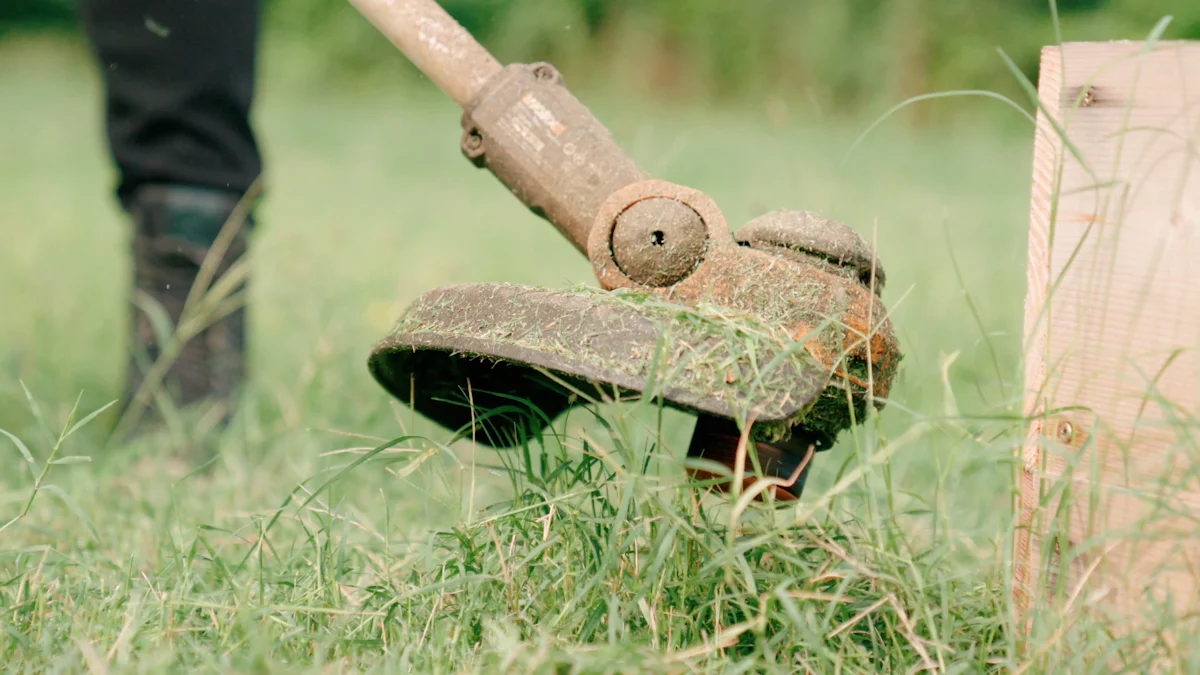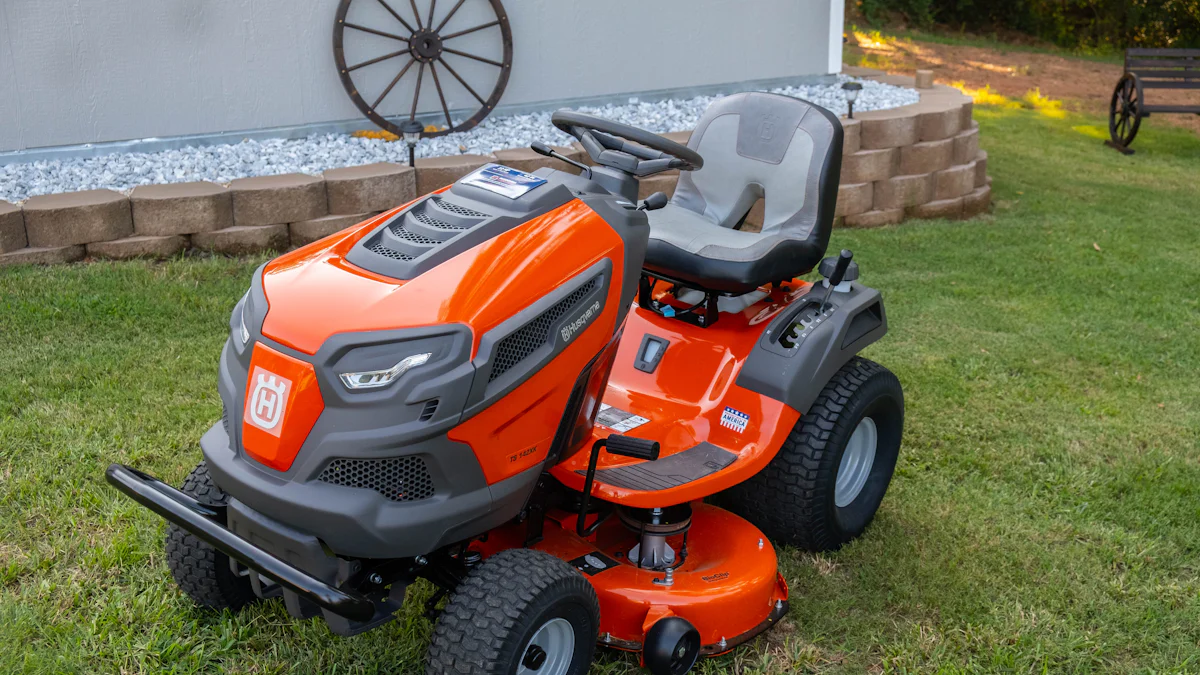How to Use a Grass Cutting Machine Effectively

A grass cutting machine makes lawn care quick and efficient, turning a tedious chore into a manageable task. Whether you're maintaining a small garden or a sprawling yard, this tool delivers precision and saves valuable time. Modern machines are equipped with advanced features like anti-vibration technology, ensuring a comfortable user experience. They are also capable of tackling overgrown brush and woody areas effortlessly, thanks to their robust blades and powerful engines. Understanding how to use a grass cutting machine properly allows you to achieve a neat, healthy lawn while minimizing physical strain. Proper usage not only improves results but also prioritizes your safety.
Key Takeaways
- Always wear appropriate safety gear, including sturdy shoes, gloves, and safety glasses, to protect yourself while mowing.
- Inspect your grass cutting machine before use to ensure blades are sharp and the equipment is in good condition, preventing accidents and improving performance.
- Clear the mowing area of obstacles like rocks and sticks to avoid damage to the machine and ensure a smooth mowing experience.
- Use proper cutting techniques, such as mowing in straight lines and rotating your mowing pattern, to achieve a clean and healthy lawn.
- Prioritize safety by staying alert and avoiding distractions while operating the machine, especially around children and pets.
- Regularly maintain your machine by cleaning it after use, sharpening blades, and storing it properly to extend its lifespan and ensure optimal performance.
- Follow the manufacturer's instructions for specific maintenance and operation guidelines to achieve the best results with your grass cutting machine.
Preparation Before Using a Grass Cutting Machine
Before you start cutting grass, preparation is key. Taking the time to get ready ensures your safety, protects your equipment, and helps you achieve the best results. Here’s how you can prepare effectively.
Wear Appropriate Safety Gear
Safety should always come first when using a grass cutting machine. Equip yourself with the right protective gear to minimize risks. Start with a pair of sturdy, closed-toe shoes to shield your feet from debris. Add long trousers to protect your legs from flying grass or small stones. Don’t forget safety glasses to guard your eyes against dust and particles.
Hearing protection is also essential, especially if you’re using a loud gas-powered machine. Padded gloves can reduce vibration and improve your grip, making the task more comfortable. If you’re working in an area with low-hanging branches or uneven terrain, consider wearing a hard hat for added protection. These simple precautions can make a big difference in keeping you safe.
Inspect the Machine
A quick inspection of your grass cutting machine can save you from unexpected issues. Check the blades to ensure they’re sharp and free of damage. Dull blades tear the grass instead of cutting it cleanly, which can harm your lawn. Look for any loose screws or bolts and tighten them as needed.
If your machine runs on fuel, inspect the fuel tank for leaks and ensure it’s filled with the correct type of fuel. For electric models, check the power cord or battery for any signs of wear. Always follow the manufacturer’s instructions for maintenance and safety checks. Turn off the machine and remove the ignition key before performing any inspection to avoid accidents.
Clear the Area
Before you start mowing, take a few minutes to clear the area. Walk through your lawn and remove any obstacles like rocks, sticks, or toys. These objects can damage the blades or get thrown by the machine, posing a hazard to you and others nearby.
Pay attention to uneven ground or hidden holes that could cause the machine to tip over. If you’re working in a yard with pets or children, make sure they’re safely out of the way. A clean and obstacle-free lawn not only protects your equipment but also ensures a smoother mowing experience.
By following these preparation steps, you’ll set yourself up for success. Knowing how to use a grass cutting machine starts with being ready, and these tips will help you get there.
How to Use Grass Cutting Machine: Operating Techniques

Operating a grass cutting machine effectively requires a mix of proper technique and attention to detail. By mastering the basics, you can achieve a clean, professional-looking lawn with minimal effort. Let’s dive into the key steps.
Starting the Machine
Starting your grass cutting machine correctly is the first step to a smooth mowing session. For gas-powered machines, move at least 10 feet away from any fuel source before starting. This reduces the risk of fire hazards. Ensure the machine is on a flat, stable surface. If your model has a primer bulb, press it a few times to help the engine start more easily. Then, pull the starter cord firmly while holding the handle securely.
For electric models, check that the battery is fully charged or the power cord is undamaged. Plug it into a safe outlet if necessary. Always follow the manufacturer’s instructions for starting your specific machine. A proper start ensures the machine runs smoothly and efficiently.
Pro Tip: Starting the machine in a well-ventilated area prevents the buildup of harmful fumes, especially with gas-powered models.
Cutting Techniques
Using the right cutting techniques makes a big difference in how your lawn looks. Begin by mowing in straight lines, overlapping slightly with each pass to avoid leaving uncut patches. Swing the mowing head from left to right if you’re using a trimmer. For rotary mowers, start on the left-hand side if the blades rotate clockwise. This ensures even cutting and reduces strain on the machine.
Rotate your mowing pattern each time you cut the grass. For example, mow horizontally one week and vertically the next. This prevents the mower’s wheels from compacting the same areas repeatedly, which can damage the grass. Keep the blades sharp to achieve clean cuts. Dull blades tear the grass, leaving it frayed and more vulnerable to disease.
Did You Know? Torn grass from dull blades not only looks messy but also stresses the lawn, making it harder for it to recover.
Handling Different Grass Types
Different grass types require different approaches. For tall or thick grass, raise the cutting height on your machine to avoid overloading the motor. Make multiple passes, cutting a little at a time, instead of trying to mow it all at once. For shorter grass, lower the cutting height for a closer trim. Always follow the recommended mowing height for your grass type to promote healthy growth.
If you’re dealing with wet grass, proceed with caution. Wet grass clumps together and can clog the machine. Wait until the lawn dries for the best results. When cutting uneven or sloped terrain, move slowly and maintain a firm grip on the machine. This ensures safety and prevents uneven cuts.
Quick Tip: Start by trimming the top third of the grass. This method reduces stress on the lawn and allows you to achieve the desired length gradually.
By mastering these operating techniques, you’ll not only learn how to use a grass cutting machine effectively but also enjoy a healthier, more attractive lawn. Practice these tips regularly, and you’ll see noticeable improvements in your mowing results.
Safety Tips for Using a Grass Cutting Machine

Using a grass cutting machine can be rewarding, but safety should always come first. By following these tips, you can protect yourself and others while ensuring a smooth mowing experience.
General Safety Precautions
Before you even start the machine, take a moment to prioritize safety. Always wear protective gear, including safety glasses, gloves, and sturdy shoes. These items shield you from flying debris and reduce the risk of injury. Avoid wearing loose clothing or jewelry that could get caught in the machine.
Keep your hands and feet away from the blades at all times. If you need to clear debris or adjust the machine, turn it off completely and wait for the blades to stop spinning. Never attempt to make adjustments while the machine is running.
Stay alert and aware of your surroundings. Watch out for pets, children, or bystanders who might wander into the area. A distracted operator is more likely to make mistakes, so focus on the task at hand.
Important Reminder: According to research, most injuries from lawn trimmers result from foreign objects like rocks or sticks. Clearing the area and wearing proper safety gear can significantly reduce these risks.
Avoiding Common Hazards
Grass cutting machines can pose several hazards if not used correctly. One common issue is objects being thrown by the blades. To avoid this, inspect your lawn beforehand and remove any rocks, branches, or other debris. Even small items can become dangerous projectiles.
Slopes and uneven terrain present another challenge. When mowing on a slope, move side-to-side rather than up and down to maintain better control. Always keep a firm grip on the machine and avoid sudden movements that could cause you to lose balance.
Be cautious when working near roads or driveways. Cars, pedestrians, and cyclists may not expect a mower in their path. Position yourself so you’re always facing oncoming traffic, and never mow too close to the edge.
Pro Tip: If you’re using an electric model, keep the power cord behind you to prevent accidental cuts or trips.
Safe Handling of Fuel or Batteries
Fuel and batteries require careful handling to ensure safety. For gas-powered machines, always refuel in a well-ventilated area, far from open flames or heat sources. Use the correct type of fuel recommended by the manufacturer, and never overfill the tank. Spilled fuel can ignite and cause serious accidents.
When dealing with electric models, inspect the battery or power cord for damage before use. Damaged cords can lead to electrical shocks or fires. If your machine uses a rechargeable battery, store it in a cool, dry place and avoid exposing it to extreme temperatures.
Turn off the machine and let it cool down before refueling or charging. This prevents overheating and reduces the risk of burns or explosions. Always follow the manufacturer’s guidelines for safe operation and maintenance.
Quick Tip: Keep a fire extinguisher nearby when working with gas-powered machines. It’s better to be prepared for emergencies.
By following these safety tips, you’ll not only learn how to use a grass cutting machine effectively but also create a safer environment for yourself and those around you. Safety isn’t just a precaution—it’s a habit that ensures every mowing session ends without incident.
Maintenance Tips for Long-Term Use
Proper maintenance keeps your grass cutting machine running smoothly and extends its lifespan. By dedicating a little time to upkeep, you can ensure consistent performance and avoid costly repairs. Let’s explore the essential maintenance steps.
Cleaning the Machine
Cleaning your grass cutting machine after every use is crucial. Grass clippings, dirt, and debris can accumulate on the blades and cleaning the machine leading to rust and reduced efficiency.
Pay special attention to the mowing deck. A dirty deck can cause corrosion over time. Scrape off any hardened debris and wipe it down with a damp cloth. If your machine has a string trimmer, replace the string when it wears down. Keeping the machine clean not only improves its performance but also ensures a longer lifespan.
Quick Tip: Avoid using water directly on the engine or electrical components. Instead, use a dry cloth or compressed air for these areas.
Storing the Machine
Storing your grass cutting machine correctly prevents damage and ensures it’s ready for the next use. Always store it in a dry, indoor space to protect it from moisture and rust. Before storing, empty the fuel tank if you’re using a gas-powered model. This prevents fuel from going stale and clogging the engine. Change the engine oil and remove the spark plug to avoid accidental starts during storage.
Elevate the machine slightly using a wooden block to keep it off the ground. Cover it with a tarp to shield it from dust and dirt. For electric models, store the battery in a cool, dry place away from direct sunlight. Proper storage keeps your machine in top condition and saves you from unnecessary repairs.
Pro Tip: Allow the machine to cool completely before storing it. This prevents heat damage to nearby items and reduces fire risks.
Sharpening and Replacing Blades
Sharp blades are essential for a clean, healthy cut. Dull blades tear the grass, leaving it frayed and more prone to disease. Inspect the blades regularly for signs of wear or damage. If they appear dull, sharpen them using a file or blade sharpener. For frequent mowing, consider sharpening the blades annually or more often.
Sometimes, blades may become too damaged to repair. In such cases, replace them with new ones that match your machine’s specifications. Always follow the manufacturer’s guidelines when sharpening or replacing blades. Well-maintained blades not only improve cutting performance but also reduce strain on the machine.
Did You Know? Balanced blades prevent vibrations that can damage the engine and other components.
By following these maintenance tips, you’ll learn how to use a grass cutting machine effectively while keeping it in excellent condition. Regular cleaning, proper storage, and blade care ensure your machine delivers reliable performance for years to come.
Using a grass cutting machine effectively starts with preparation. You need to inspect your equipment, wear proper safety gear, and clear the area. During operation, focus on using the right techniques for cutting and handling different grass types. Prioritize safety by staying alert and following precautions, especially when dealing with fuel or batteries. Regular maintenance, like cleaning and sharpening blades, ensures your machine stays in top condition. By mastering these steps, you’ll not only achieve a healthy, well-maintained lawn but also extend the life of your equipment. Always refer to your manufacturer’s instructions for the best results.
FAQ
What is a grass cutting machine?
A grass cutting machine is a tool designed to trim grass to a uniform height. It uses one or more blades to achieve a clean and even cut. These machines come in various types, including manual, electric, and gas-powered models, each suited for different lawn sizes and needs.
What are the advantages of using a grass cutting machine?
Using a grass cutting machine offers several benefits. It’s highly versatile, allowing you to tackle different grass types and terrains.
How do I choose the right grass cutting machine for my lawn?
To pick the right machine, consider your lawn size and type. For small lawns, an electric or manual mower works well. For larger areas, a gas-powered model provides the power needed for efficient mowing. Think about the terrain too. Uneven or sloped lawns may require a machine with adjustable cutting heights or self-propelling features.
Can I use a grass cutting machine on wet grass?
It’s best to avoid cutting wet grass. Wet grass clumps together, which can clog the machine and reduce its efficiency. It also makes the lawn slippery, increasing the risk of accidents. Wait until the grass dries for a cleaner cut and a safer mowing experience.
How often should I mow my lawn?
The frequency depends on the grass type and growth rate. A general rule is to mow once a week during the growing season. Avoid cutting more than one-third of the grass height at a time. This promotes healthy growth and prevents stress on the lawn.
What safety precautions should I take when using a grass cutting machine?
Always wear protective gear, including safety glasses, gloves, and sturdy shoes. Inspect the machine before use to ensure it’s in good condition. Clear the area of debris like rocks and sticks to prevent hazards. Stay alert and keep children and pets away while operating the machine.
How do I maintain my grass cutting machine?
Regular maintenance keeps your machine in top shape. Clean the blades and mowing deck after each use to remove grass clippings and debris. Sharpen the blades periodically for a clean cut. Store the machine in a dry, indoor space to protect it from rust and damage. Follow the manufacturer’s guidelines for specific maintenance tasks.
Can I use the same machine for different grass types?
Yes, but you may need to adjust the cutting height or use specific blades for optimal results. For tall or thick grass, raise the cutting height to avoid overloading the motor. For shorter grass, lower the height for a closer trim. Always check your machine’s manual for recommendations.
What should I do if my grass cutting machine doesn’t start?
If your machine doesn’t start, check the basics first. For gas-powered models, ensure the fuel tank is filled with the correct fuel and inspect the spark plug. For electric models, verify that the battery is charged or the power cord is undamaged. If the issue persists, consult the manufacturer’s troubleshooting guide or seek professional help.
Why is my lawn uneven after mowing?
Uneven mowing can result from dull blades, improper cutting height, or inconsistent mowing patterns. Sharpen the blades to ensure a clean cut. Adjust the cutting height to match your lawn’s needs. Mow in overlapping straight lines and alternate the mowing direction each time to achieve an even finish.
See Also
Maximizing Efficiency With Your Laser Cutting Machine
Essential Advice for Operating a Meat Cutting Machine
Understanding the Cost and Longevity of Grass Cutters
